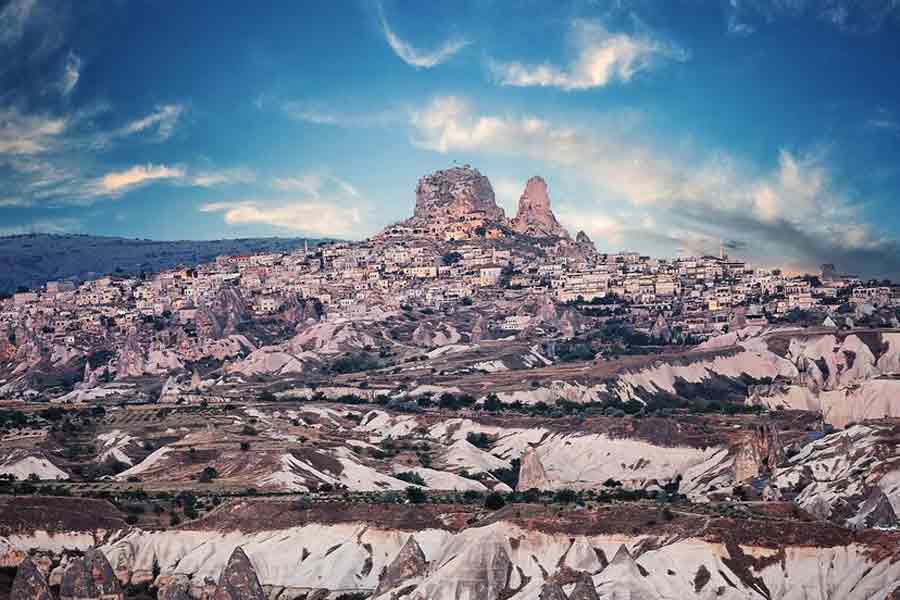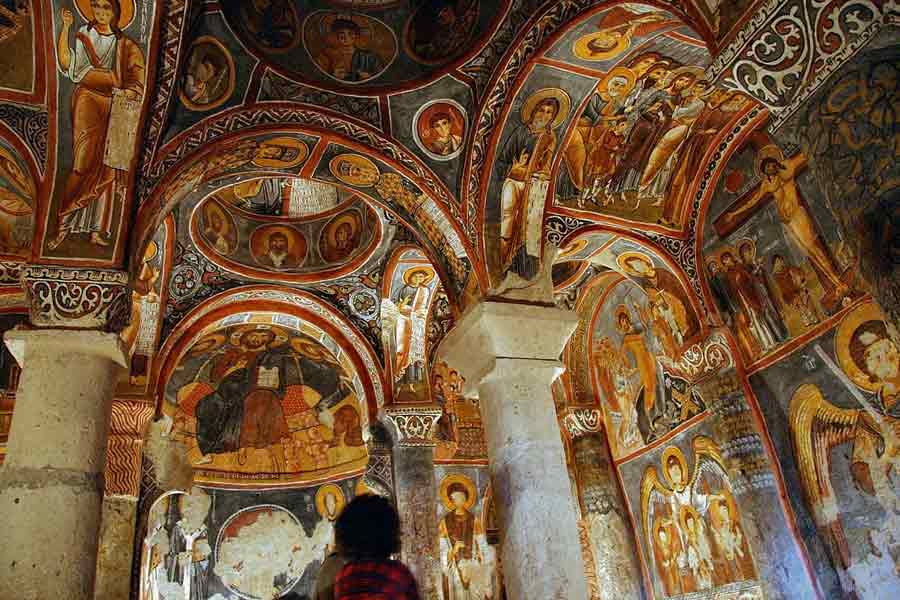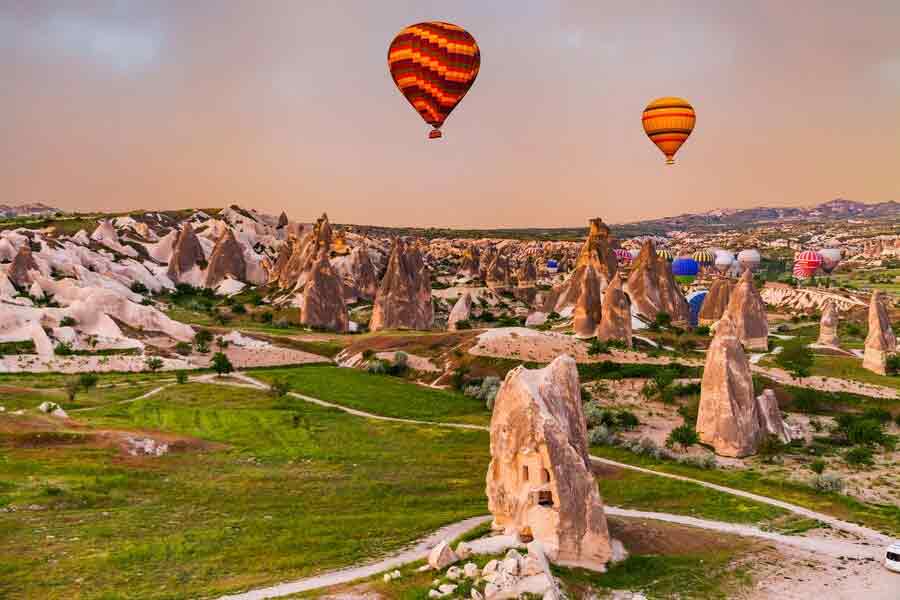Most museums are designed in glass buildings but in Cappadocia, the authentic cave dwellings that connect to the past are open air. Located uphill, in the most popular town in Cappadocia is Goreme Open Air Museum. It’s one of the first designated UNESCO World Heritage site in Turkey during 1984. Goreme Open Air Museum offers a wealth of history. It has triple the entrance fee compared to Zelve Open-Air Museum. This can be attributed to the value of paintings found inside the churches.
Goreme Open Air Museum History
Thousands of years ago, nearby Mount Erciyes volcano erupted. Ash and lava fell across the landscape and hardened to form tufa rock. Over centuries to come, wind erosion slowly moulded fairy chimneys that we see today.However, it didn’t take centuries for locals to realise they could carve into rocks and soon turned them into houses and churches.
From then on, Cappadocia offered sanctuary to early Christians who decorated them with art and symbols. The churches also flourished under the guise of Saint Basil of Caesarea, one of three renowned Cappadocian Fathers who advanced early Christian theology.
The 4th-century sanctuaries include many examples of Byzantine art, but later structures offer richer frescoes and images. Adorning walls and ceilings, they portray Biblical scenes, and their primary purpose was to help followers who couldn’t read or write.
Unfortunately, when the Ottoman rule came to Cappadocia, locals used the caves as pigeon sheds, because they were not aware of their historical importance. It took many historians many years to clean and restore the frescoes to return them to their original condition. As a member of the UNESCO World Heritage list since 1984, most date from the 9th to 12th centuries.
An Excellent Day in Göreme Open Air Museum!
As you begin an impressive Goreme Open Air Museum tour, you will see a box office. Entrance fee of an open-air museum in Turkey can be a bit higher than others. Turkish citizens can access these museums free of charge through the Muzekart application. If you didn’t come with a tour, you can get an adult Muzekart. It is possible to have Muzekart from the box office at the entrance of the museum. However, in order to access all the necessary places free of charge, we strongly recommend you to join a Cappadocia Tour. In this way, you can ensure that you are going to visit all the must be visited places and you are not going to be cheated about charges.
When you enter Göreme Open Air Museum, you will see quite high structures. Within these stone structures, there are many churches located very close to each other. These churches are generally built between the 4th century BC and the 13th century BC. All of the churches and other structures were carved into the rocks. Although the region hosts many churches, it is not open to all. This is why some areas within the museum have been closed with chains and various barriers.
Nunnery (Rahibeler Manastırı)
Nunnery is a remarkable rock-carved convent with six floors of tunnels, corridors, stairways and chambers, situated left of the entrance to the museum. It housed as many as 300 nuns at any one time. The dining hall, kitchen and some rooms on the first floor, together with the ruined chapel on the second floor, used to be open to public until quite recently but now the complex can only be admired from the outside.
St. Basil's Church (Aziz Basil Şapeli)
St. Basil's Church has a rectangular nave with niches and three apses, separated from a narthex by arches. The narthex has tombs in the floor, which are open but covered with metal grating. The decoration is typical of the iconoclastic period, when images were outlawed – red ochre was painted on the stone without any images of people or animals. Subjects in this church include Christ, St. George, St. Basil and St. Theodore. The three Maltese crosses on the vault of the nave are believed to represent the Holy Trinity.
Apple Church (Elmalı Kilise)
One of the most prominent buildings in the area with its vivid colors, the church is a groin-vaulted structure with cross-in-square plan, having four columns and a central dome. The frescoes of the Apple Church mostly date from the 11th century. In places they have fallen off and simple red-painted ornaments from the iconoclastic period can be seen. The frescoes are narrating scenes from the Bible and the life of Christ, the hospitality of Abraham and three Hebrew youths. The building probably got its name from a red orb held by St. Michael the Archangel in a fresco near the entrance, but an alternative theory is that it got its name from an apple orchard which used to be in front of the main entrance a long time ago.
St. Barbara Chapel (Azize Barbara Kilisesi)
This church is situated behind the rock housing Apple (Elmalı) Church. This cruciform chapel with three apses is mostly decorated with simple figures and symbols in red paint on white plaster, making a sharp contrast with the colorful figures of most Göreme churches. They may have been painted shortly after the 8th-century iconoclastic controversy. A giant locust symbolizing evil on one wall opposes two crosses on the other, while a rooster representing the devil is battled with bricks representing the Church. Other strange creatures and shapes are more difficult to interpret. The figurative frescoes include Christ Pantocrator, St. George and the dragon, St Theodore, and St Barbara.
Snake Church (Yılanlı Kilise)
The Snake Church has a long nave with a low, barrel-vaulted ceiling. Among the paintings are portraits of St. Theodore, St. George slaying the dragon again (it looks like a snake, which gave the chapel its name), Emperor Constantine and his mother St. Helena, and St. Onuphrius. The last saint was an Egyptian hermit who lived near Thebes. In medieval art, including in this example, he is usually depicted with a long gray beard, wearing nothing but a fig leaf.
Dark Church (Karanlık Kilise)
The Dark Church, called so because it gets very little light, was used as a pigeon house until the 1950s. It took 14 years to scrape pigeon droppings off the walls, but underneath were beautifully preserved 11th-century frescoes. Recently restored, the paintings of New Testament scenes and other subjects are considered the best-preserved frescoes in Cappadocia.
St. Catherine's Chapel
Built by a donor named Anna, the chapel of St. Catherine dates from the 11th century. It has a Greek-cross-shaped nave, with a dome over the center and barrel-vaulted cross arms. The narthex has nine floor tombs and two burial niches. The frescoes depict: a Deesis (in the apse); Doctors of the Church: Gregory, Basil the Great and John Chrysostom; St. George, St. Theodore, and St. Catherine.
Sandals Church (Çarıklı Kilise)
This church is named because of two footprints just inside the entrance, the last imprints left by Jesus before he ascended to heaven. A fresco of the Ascension can be seen directly above. The narthex of the church has collapsed; the nave has a cross plan with barrel vaults and well-preserved frescoes. The fresco subjects are New Testament scenes such as the Nativity, Adoration of the Magi, and the Baptism of Christ. The scenes of the way of the cross and the descent from the cross make this church different from the others. The main cupola has a Christ Pantocrator with the four Evangelists below; the other three cupolas show angels Michael, Gabriel and Uriel. In the apse is a Deesis (Christ with Mary and John the Baptist), with an inscription next to Christ reading "I am the light of the world, who follows me will not be left in the dark." Around the altar are saints: Blaise, Gregory of Nazianzus, Basil, Chrysostom and Hypatius. The church dates back to the end of the 12th and the beginning of the 13th centuries.
Buckle Church (Tokalı Kilise)
Just outside the museum exit on the other side of the road is the Buckle Church, the largest of the cave churches at Göreme. It can be entered with the same ticket as the main complex and should not be missed. The frescoes are also the finest in Göreme, with the richest colors and the most detail. It dates from the 10th and 11th centuries and was restored in the 1960s.
The Buckle Church is comprised of four chambers, which are known as the Old Church, New Church, Paracclesion and Lower Church. The Old Church (10th century) has a single nave with a barrel vault. The frescoes give a comprehensive account of the life of Christ, from the Annunciation through the Baptism and Miracles and ending with the Passion, Resurrection and Ascension. The Transfiguration is painted over the entrance and the vault has portraits of saints. The Old Church now acts as a narthex for the New Church, which was added to the former's east side around 990-1010 AD. Its barrel-vaulted nave tells the story of Christ in deep red and blue hues. The transverse nave has frescoes of saints, scenes from the life of St. Basil, and the miracles of Christ.




